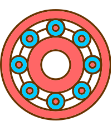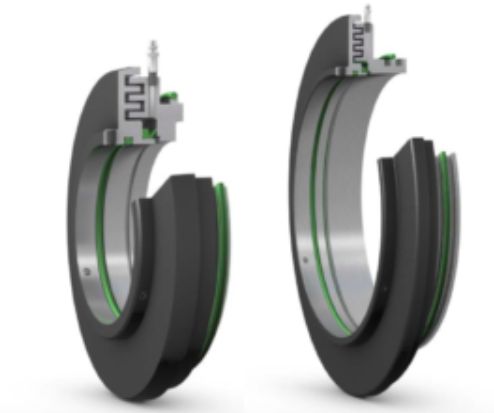If the component undergoes case carburization and hardening, plastic indentation results from both case and core deformation. The partition between these contributions depends on the relative case depth (𝑐 /𝐷𝑤). Here, case depth 𝑐 is defined as the depth at which hardness is equal to HV550. Following Lai et al.:
where [𝛿 /𝐷𝑤]case and [𝛿 /𝐷𝑤]core are plastic indentations for case and core materials, respectively, given by Eq. (1). the partitioning parameter ρ in the above equation is a function of the relative case depth 𝑐 /𝐷𝑤 and contact pressure:
where 𝑝r is a reference pressure set to 1000 MPa. Constants G, u and v are determined by fitting Eq. (2) with Eq. (3) to plastic indentation data obtained from FE calculations. Note that the static load rating for through-hardened bearings is defined as the contact pressure that corresponds to a surface plastic indentation depth of 10^-4𝐷𝑤.
Elliptical contact plastic indentation [𝛿 /𝐷𝑤]EC results from interpolation based on the b /𝑎 ratio between solutions for point and line contacts.
From the FE analysis, we explore the material response regarding plasticity-induced residual stress. When the stress from a static load surpasses the yield strength of the core material, plastic flow occurs, leading to subsurface material damage in the form of residual stress. Fig. 2a illustrates a tensile residual stress zone in the case-core transient region resulting from a high-contact stress. A comparable residual stress pattern was identified in surface induction-hardened parts subjected to ball or roller indentation, as demonstrated in a previous study. That study revealed that under SCF loading conditions, tensile residual stress may induce cracking or delamination at the case and core interface.
The expression for subsurface tensile residual stress due to standing contact loading, previously established, proves applicable to case-carburized components:
in which 𝜎y is the yield strength of the core material, 𝜎vM is the equivalent von Mises stress at a depth of 𝑐 from the surface or the depth at which the hardness is equal to HV550. C0, C1 and C2 are constants, which can be determined by fitting Eq. (5) to the FE results. It’s important to note that the von Mises stress here is evaluated using the Hertzian theory of elastic contact, representing the stress solution under the assumption of linear elasticity. Fig. 2b shows the tensile residual stresses as a function of the equivalent von Mises stress at a depth of 𝑐 from the surface for line contact and point contact, respectively. The critical stress, Sc, can be assessed using the principles of fracture mechanics and the El Haddad approach to consider small crack effects, as detailed in our prior work.
Home Produttori SKF Materiali di approfondimento: cuscinetti cementati a caso sottoposti a carico statico di...










